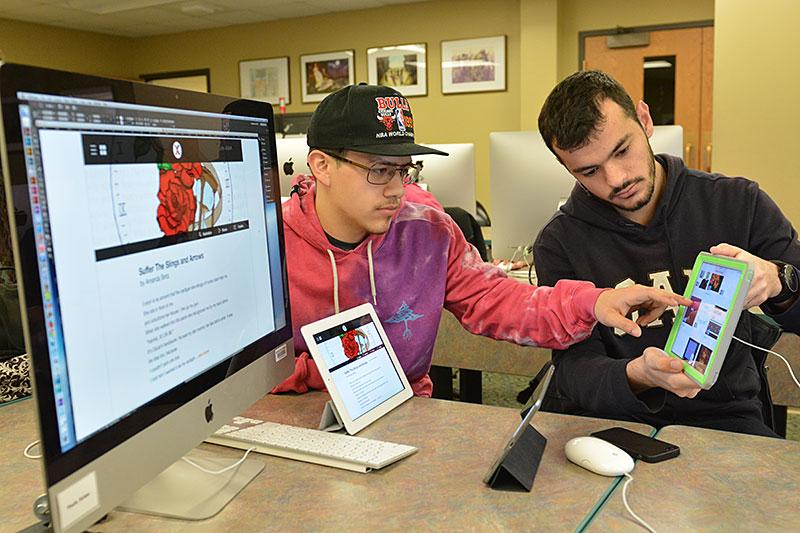Multimedia flash—SUNY Oswego senior graphic design majors Julio Valenzuela (left) and Guilherme Assis display a part of the work that has gone into the Exist magazine app, a collaborative project of student artists, writers, illustrators, filmmakers, musicians, editors, designers and more based on the Graphic Flash fiction-and-artwork exhibitions of recent semesters. Issue 1 of the app is available online for iPad, with the second issue to follow soon. Some of the students working on each issue will appear at the SUNY Undergraduate Research Conference on April 10 and at Quest on April 15.
SUNY Oswego students blending creative writing, illustration, filmmaking, music, design and computer skills have teamed the last two semesters to launch Exist, a multimedia magazine app inspired by the college’s Graphic Flash fiction-and-artwork exhibitions.
With the assistance of nearly $10,000 from a SUNY Innovative Instruction Technology Grant, classes in graphic design, creative writing, cinema and screen studies, music, journalism and others published Volume 1, Issue 1 of Exist, available for free on Appster for iPad, and are hard at work on Issue 2.
The collaborative e-publications and some of their creators will make appearances at two scholarly gatherings in the near future, the first-ever SUNY Undergraduate Research Conference on April 10 and the college’s long-running Quest on April 15.
Art faculty member Kelly Roe worked with art chair Cynthia Clabough on the grant, then with her “Graphic Design for Publication” class and students in other disciplines last fall and over part of winter break to produce the first issue of Exist, featuring Graphic Flash stories and artwork. Leigh Wilson of the English and creative writing department and Amy Bartell of art launched Graphic Flash in 2012 to marry students’ short fiction pieces with illustration and, in subsequent semesters, with music and short films.
“It’s been a real learning experience for all of us,” Clabough said. “We wanted to see if we could stretch the boundaries of what one can call a magazine.”
Heightened interactivity
Cara Brewer Thompson’s “Multimedia II” graphic design class is working this semester on taking Exist to new levels of multimedia storytelling and user-friendly interactivity. Julio Valenzuela, a first-semester senior in Thompson’s class, works closely with Guilherme Assis, a senior on campus with the Brazil Scientific Mobility Program, on an animation for a Graphic Flash presentation in Exist.
They use iPad Air 2s purchased with the aid of the SUNY grant. Working in Adobe Edge digital publishing suite and employing some scripting software, the students created an animation for a Graphic Flash illustration that responds to the iPad’s position, making it seem gravity-fed.
“This is a nice collaborative group,” Valenzuela said. “Working as a team relates to the real world.” Designing and publishing an app will make a strong addition to students’ portfolios as they search for jobs, he added.
By emphasizing student ownership of Exist, Thompson said, “they took more care with decisions than they might if they had orders dictated to them. (E-publishing) gives them a sense of pride and confidence.”
Clabough, who also credits SUNY Oswego web development and technical staff with assisting the Exist publishing effort, foresees three issues of the magazine a year—in spring, summer and fall—as a cross-campus, experiential-learning-style incubator for talent and teamwork.
As a requirement of the SUNY grant, students need to not only publish the Exist app, but also follow through with promotion and marketing. “This lets us take all the way through something we could only practice in theory,” Clabough said.
“We’d like to evolve that (learning environment) more to really bring to the fore how an editorial team would work,” she said. “We’re going to study it to see how these collaborations can work, and better it.”
Others are also thinking ahead. Wilson would like her spring 2016 creative writing students to develop their flash fiction using a published young-adult story as a base, creating new possibilities for story arcs in the tight count of 250 words. Roe plans to have her students—and others around campus—tackle publishing Issue 3 of Exist this fall, potentially seeking new ground for collaboration at the college and perhaps beyond.




